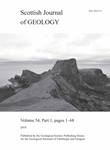 Although published only since 1965, the Scottish Journal of Geology has a long pedigree. It is the joint publication of the Geological Society of Glasgow and the Edinburgh Geological Society, which prior to 1965 published separate Transactions: from 1860 in the case of Glasgow and 1863 for Edinburgh.
Although published only since 1965, the Scottish Journal of Geology has a long pedigree. It is the joint publication of the Geological Society of Glasgow and the Edinburgh Geological Society, which prior to 1965 published separate Transactions: from 1860 in the case of Glasgow and 1863 for Edinburgh.
The Scottish Journal of Geology (SJG) is available online via the Lyell Collection. Please see subscription rates for access entitlements.
Traditionally, the Journal has acted as the focus for papers on all aspects of Scottish geology and its contiguous areas, including the surrounding seas. The publication policy has always been outward looking, with the Editors encouraging review papers and papers on broader aspects of the earth sciences that cannot be discussed solely in terms of Scottish geology.
The diverse geology of Scotland continues to provide an important natural laboratory for the study of earth sciences; many seminal studies in geology have been carried out on Scottish rocks, and over the years the results of much of this work had been published in the Journal and its predecessors.
The Journal fully deserves its high reputation worldwide and intends to maintain its status in the front rank of publications in the Earth sciences.
The Journal is abstracted and/or indexed in:
- Current Contents
- Science Citation Index
- GeoArchive, Geobase
- Petroleum Abstracts
- Geological Abstracts
- Mineralogical Abstracts
- IBZ/IBR
Early Career Research Collection
Following the success of the Special Issue for Early Career Research, the Scottish Journal of Geology will continue to celebrate the contribution to knowledge of early-career researchers, by extending this special issue into an ongoing collection of early career research. We invite high-quality papers on any aspect of Scottish geology and geomorphology, and international papers from Scottish-based researchers.
This collection welcomes submissions based on MSc, PhD and postdoctoral research, and from geologists within five years of their first professional appointment. Types of contribution may include:
- Original research papers
- Short communications
- Review papers offering new perspectives
The submission must have an early career author either as single or lead author. If you have any queries please contact the Journal Manager at [email protected].
For more information, see the early career section on our author information page.
Recent highlights
New postcranial remains from the Lealt Shale Formation of the Isle of Skye, Scotland, showcase hidden pterosaur diversity in the Middle Jurassic
By Natalia Jagielska, Thomas J. Challands, Michael O'Sullivan, Dugald A. Ross, Nicholas C. Fraser, Mark Wilkinson, and Stephen L. Brusatte
The Early to Middle Jurassic transition was significant in pterosaur evolution, during which these volant reptiles exploded in diversity alongside dinosaurs and other animals. It has long been thought, however, that pterosaurs did not develop large wingspans until after the Jurassic, a notion challenged by the recent discovery of Dearc sgiathanach in the Bathonian-aged Lealt Shale Formation of the Isle of Skye, Scotland, whose holotype specimen had an estimated wingspan greater than 2.5m.
Read the full paper in the Lyell Collection
Combining ground stability investigation with exploratory drilling for mine water geothermal energy development; lessons from exploration and monitoring
By D. B. Walls, D. Banks, A. J. Boyce, D. H. Townsend, and N. M. Burnside
Mine water geothermal energy's potential for decarbonization of heating and cooling in the UK has led to increased national interest and development of new projects. In this study, mine water geothermal exploration has been coupled with ground investigation techniques to assess ground stability alongside seasonal mine water hydrogeology and geochemistry.
Read the full paper in the Lyell Collection